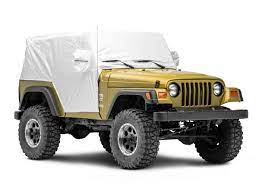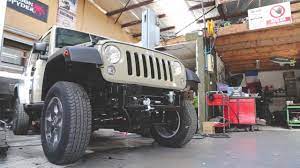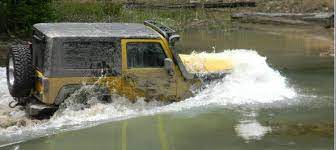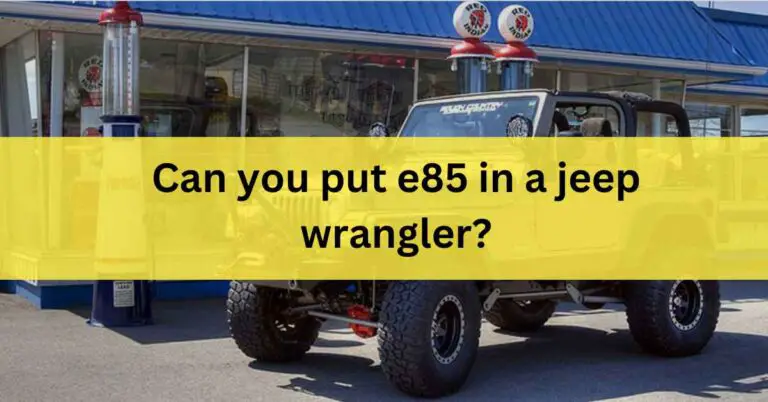Are Jeep Wranglers Good In The Rain? – Latest Guide In 2023
Jeep Wranglers are popular vehicles known for their rugged, off-road capabilities and a strong reputation for durability and reliability.
However, many people wonder if Jeep Wranglers are good in the rain, given their open-air design and lack of a traditional roof.
Jeep Wranglers are equipped with four-wheel drive (4×4) traction, heavy components that prevent them from sliding, and sealed electrical ports that prevent various hazards, so they perform exceptionally well when it rains.
Table of Contents
The interior of the Wrangler is water-resistant as well, and it has drain plugs to remove any excess moisture that may have accumulated from rainy days or water fording.
In this article, we will examine the factors that can affect the rain performance of Jeep Wranglers and explore how water enters the Jeep Wrangler in wet conditions.
Are Jeep Wranglers Good In The Rain?
Jeep Wranglers are generally considered to be capable vehicles in wet conditions, but it’s important to keep in mind that no vehicle is completely immune to the challenges posed by rain.
Here is a comprehensive look at the factors that can affect the rain performance of Jeep Wranglers:
1. Traction And Stability:
One of the main advantages of Jeep Wranglers in wet conditions is their four-wheel drive (4WD) and high clearance.
These features can provide extra traction and stability on slippery roads, helping the vehicle maintain control and avoid accidents.
Additionally, Jeep Wranglers have a relatively low center of gravity, which can further improve their stability in wet conditions.
However, it is still important to drive carefully and maintain a safe speed when the roads are slick, as any vehicle can lose traction on wet surfaces.
2. Water Protection:
Although Jeep Wranglers do not have a traditional roof to protect against water, they have several features that can help prevent water damage.

For example, the electrical systems are sealed, and the engine is mounted high, which can help prevent water from entering and causing damage.
However, the open-air design of Jeep Wranglers does not provide the same level of protection from the elements as a traditional, fully-enclosed vehicle.
3. Visibility:
One of the main challenges of driving a Jeep Wrangler in the rain is visibility.
The open-air design can make it more difficult to see out of the vehicle, especially if the windows are up and the wipers are not working effectively.
Use caution and drive slowly when visibility is poor to minimize the risk of an accident.
4. Comfort:
Driving a Jeep Wrangler in the rain can be a less comfortable experience than driving a traditional, fully-enclosed vehicle.
You may feel cold and wet even if the windows are up without a roof to keep out the rain and wind.
The open-air design can make it more difficult to hear the radio or converse with passengers.
5. Maintenance And Preparation:
Proper maintenance and preparation can also play a role in the performance of a Jeep Wrangler in the rain.
It is important to ensure the wipers and other essential systems are in good working order, as they can greatly affect your visibility and control of the vehicle in wet conditions.

You may consider investing in rain gear or installing a hardtop to provide additional protection from the elements.
Can Jeep Wranglers Get Wet Inside?
The interior of a Jeep Wrangler can get wet if it is driven in the rain or if water enters the vehicle in some other way.
The open-air design of Jeep Wranglers means that they do not have a traditional roof to protect against water, so it is important to take extra precautions to keep the interior dry.
There are a few ways that water can enter a Jeep Wrangler and get the interior wet:
1. Driving In The Rain:
If a Jeep Wrangler is driven in the rain, water can splash up from the road and onto the vehicle, potentially getting the interior wet.
This can be especially problematic if the windows are down or the vehicle has a soft top.
2. Water Leaks:
Another way that water can enter a Jeep Wrangler and get the interior wet is through leaks.
This can happen if the vehicle has a damaged or improperly installed hardtop, if the seals around the doors or windows are worn or damaged, or if there is a problem with the drain tubes designed to direct water away from the interior.
3. Water Splashing:
Water can also enter a Jeep Wrangler and get the interior wet if it splashes onto the vehicle while driving through puddles or streams. This can be more of a problem if the vehicle has a soft top or the windows are down.
To help prevent the interior of a Jeep Wrangler from getting wet, it is important to take the following precautions:
4. Use A Hardtop:
If your Jeep Wrangler is equipped with a hardtop, ensure it is properly installed and in good condition. A hardtop can provide a more secure and waterproof barrier against water than a soft top.
5. Keep The Windows Up:
Keeping the windows up can help prevent water from splashing into the vehicle and getting the interior wet.
If you need to drive with the windows down, consider installing window guards or deflectors to help redirect water away from the interior.
6. Check For Leaks:
Regularly check for leaks around the doors, windows, and other areas of the vehicle to ensure that water is not entering the interior. If you do find a leak, have it repaired as soon as possible to prevent further water damage.
7. Use Floor Mats:
Installing floor mats or liners can help protect the interior of your Jeep Wrangler from water and other types of damage.
Make sure to clean and dry the mats regularly to prevent water from accumulating and potentially causing damage.
Can Jeep Wranglers Drive Submerged In Water?
It is generally not recommended to drive a Jeep Wrangler or any other vehicle through deep or submerged water. Driving through deep water can be dangerous and can potentially cause damage to the vehicle.
However, driving through deep water can be risky for several reasons:
1. Water Can Enter The Engine:
If water enters the engine of a Jeep Wrangler or any other vehicle, it can cause serious damage to the engine and other components.

Water can get into the engine through the air intake or other openings, potentially resulting in engine failure or other problems.
2. Water Can Affect The Brakes:
Driving through deep water can also affect the brakes of a Jeep Wrangler or any other vehicle.
Water can get into the brake lines and cause the brakes to fail or become less effective, which can be dangerous when driving.
3. Water Can Damage Other Systems:
In addition to the engine and brakes, driving through deep water can also cause damage to other systems and components of a Jeep Wrangler or other vehicles.
For example, water can get into the electrical system, transmission, and other areas, potentially causing problems and requiring costly repairs.
Conclusion:
Jeep Wranglers can be good in the rain if you take the necessary precautions and drive carefully.
To maintain a safe speed, use caution when visibility is poor and ensure the wipers and other essential systems are in good working order.
While the open-air design of Jeep Wranglers may not provide the same level of protection from the elements as a traditional vehicle, they are still capable of handling wet conditions with the right approach and preparation.
Similar post:




![Jeep Radio Won’t Turn Off [How To Solve This In 2023]](https://garagegrabber.com/wp-content/uploads/2023/01/jeep-radio-wont-turn-off-768x402.jpeg)


